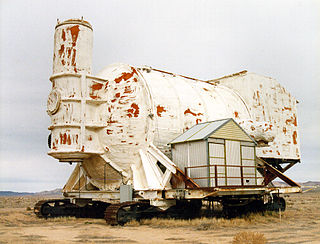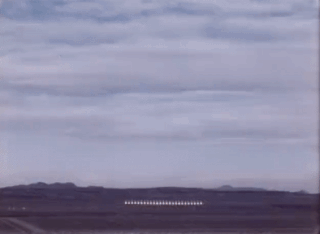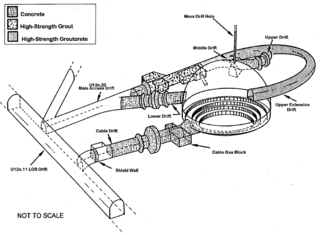| Operation Anvil | |
|---|---|
 Anvil Husky Pup test chamber 1. | |
| Information | |
| Country | United States |
| Test site |
|
| Period | 1975–1976 |
| Number of tests | 21 |
| Test type | underground shaft, tunnel |
| Max. yield | 1 megatonne of TNT (4.2 PJ) |
| Test series chronology | |
Operation Anvil [1] was a series of 21 nuclear tests conducted by the United States in 1975–1976 at the Nevada Test Site. These tests followed the Operation Bedrock series and preceded the Operation Fulcrum series.
| Name [note 1] | Date time (UT) | Local time zone [note 2] [2] | Location [note 3] | Elevation + height [note 4] | Delivery [note 5] Purpose [note 6] | Device [note 7] | Yield [note 8] | Fallout [note 9] | References | Notes |
|---|---|---|---|---|---|---|---|---|---|---|
| Marsh | September 6, 1975 17:00:00.113 | PST (–8 hrs) | NTS Area U3kb 37°01′25″N116°01′45″W / 37.02362°N 116.02909°W | 1,187 m (3,894 ft) – 427.21 m (1,401.6 ft) | underground shaft, weapons development | 7 kt | [1] [3] [4] [5] [6] | |||
| Peninsula (aborted) | October 23, 1975 | PST (–8 hrs) | NTS Area near U2em | 1,220 m (4,000 ft) + | underground shaft, | no yield | Became stuck in shaft while being lowered; abandoned, later destroyed by Tinderbox/Azul. | |||
| Husky Pup | October 24, 1975 17:11:26.093 | PST (–8 hrs) | NTS Area U12t.03 37°13′18″N116°10′49″W / 37.22174°N 116.18019°W | 2,036 m (6,680 ft) – 327.96 m (1,076.0 ft) | tunnel, weapon effect | 15 kt | [1] [3] [5] [6] [7] | |||
| Kasseri | October 28, 1975 14:30:00.16 | PST (–8 hrs) | NTS Area U20z 37°17′24″N116°24′45″W / 37.29°N 116.41244°W | 1,957 m (6,421 ft) – 1,264.92 m (4,150.0 ft) | underground shaft, weapons development | B77 | 1 Mt | Venting detected | [1] [5] [6] [7] [8] [9] | Full yield test of the B77/B83 [10] |
| Deck | November 18, 1975 15:30:00.113 | PST (–8 hrs) | NTS Area U3kd 37°01′13″N116°01′17″W / 37.02031°N 116.02143°W | 1,185 m (3,888 ft) – 326.14 m (1,070.0 ft) | underground shaft, weapons development | 5 kt | [1] [5] [6] | |||
| Inlet | November 20, 1975 15:00:00.093 | PST (–8 hrs) | NTS Area U19f 37°13′30″N116°22′06″W / 37.2249°N 116.36845°W | 2,025 m (6,644 ft) – 818.33 m (2,684.8 ft) | underground shaft, weapons development | W78 | 500 kt | [1] [3] [5] [6] [7] [9] | ||
| Leyden | November 26, 1975 15:30:00.163 | PST (–8 hrs) | NTS Area U9cm 37°07′02″N116°01′11″W / 37.11721°N 116.01975°W | 1,303 m (4,275 ft) – 326.11 m (1,069.9 ft) | underground shaft, weapons development | 5 kt | [1] [3] [5] [6] [7] | |||
| Chiberta | December 20, 1975 20:00:00.164 | PST (–8 hrs) | NTS Area U2ek 37°07′39″N116°03′45″W / 37.1276°N 116.06244°W | 1,264 m (4,147 ft) – 716 m (2,349 ft) | underground shaft, weapons development | B77 | 160 kt | [1] [3] [4] [5] [6] [9] | ||
| Muenster | January 3, 1976 19:15:00.162 | PST (–8 hrs) | NTS Area U19e 37°17′47″N116°20′03″W / 37.2965°N 116.33407°W | 2,082 m (6,831 ft) – 1,452.4 m (4,765 ft) | underground shaft, weapons development | (reduced yield?) | 800 kt | [1] [3] [5] [6] [7] | B77 Components Tested [11] | |
| Keelson | February 4, 1976 14:20:00.112 | PST (–8 hrs) | NTS Area U7ai 37°04′09″N116°01′52″W / 37.06921°N 116.03103°W | 1,218 m (3,996 ft) – 639.62 m (2,098.5 ft) | underground shaft, weapons development | W76 | 150 kt | [1] [3] [4] [5] [6] [9] | ||
| Esrom | February 4, 1976 14:40:00.163 | PST (–8 hrs) | NTS Area U7ak 37°06′24″N116°02′18″W / 37.10655°N 116.03829°W | 1,258 m (4,127 ft) – 654.6 m (2,148 ft) | underground shaft, weapons development | B77 | 160 kt | Venting detected, 88 Ci (3,300 GBq) | [1] [3] [5] [6] [8] [12] [9] | |
| Fontina | February 12, 1976 14:45:00.163 | PST (–8 hrs) | NTS Area U20f 37°16′17″N116°29′22″W / 37.27136°N 116.48934°W | 1,837 m (6,027 ft) – 1,219 m (3,999 ft) | underground shaft, weapons development | 900 kt | [1] [3] [5] [6] [7] | |||
| Cheshire | February 14, 1976 11:30:00.162 | PST (–8 hrs) | NTS Area U20n 37°14′33″N116°25′16″W / 37.242611°N 116.42113°W | 1,947 m (6,388 ft) – 1,167 m (3,829 ft) | underground shaft, weapons development | B77 | 350 kt | [1] [3] [5] [6] [7] [9] | See Whetstone/Cambric. A test of groundwater mobility in moving buried radiaoactives, this time in volcanic rock/soil. | |
| Shallows | February 26, 1976 14:50:00.091 | PST (–8 hrs) | NTS Area U3jf 37°01′43″N116°00′59″W / 37.02851°N 116.01649°W | 1,188 m (3,898 ft) – 244.85 m (803.3 ft) | underground shaft, weapons development | W78 primary? | 2.5 kt | Venting detected | [1] [4] [5] [6] [8] [9] | |
| Estuary | March 9, 1976 14:00:00.094 | PST (–8 hrs) | NTS Area U19g 37°18′34″N116°21′56″W / 37.30955°N 116.36549°W | 2,025 m (6,644 ft) – 856.79 m (2,811.0 ft) | underground shaft, weapons development | W78 | 350 kt | [1] [3] [5] [6] [7] [9] | ||
| Colby | March 14, 1976 12:30:00.163 | PST (–8 hrs) | NTS Area U20aa 37°18′21″N116°28′21″W / 37.30594°N 116.47237°W | 1,904 m (6,247 ft) – 1,273.4 m (4,178 ft) | underground shaft, weapons development | B77 | 800 kt | Venting detected, 44 Ci (1,600 GBq) | [1] [5] [6] [7] [8] [9] | |
| Pool | March 17, 1976 14:15:00.09 | PST (–8 hrs) | NTS Area U19p 37°15′21″N116°19′46″W / 37.25584°N 116.32946°W | 2,076 m (6,811 ft) – 881.18 m (2,891.0 ft) | underground shaft, weapons development | W78 | 500 kt | [1] [3] [5] [6] [7] [9] | ||
| Strait | March 17, 1976 14:45:00.091 | PST (–8 hrs) | NTS Area U4a 37°06′26″N116°03′16″W / 37.10716°N 116.05432°W | 1,243 m (4,078 ft) – 782.42 m (2,567.0 ft) | underground shaft, weapons development | 210 kt | [1] [3] [4] [5] [6] | |||
| Mighty Epic | May 12, 1976 19:50:00.17 | PST (–8 hrs) | NTS Area U12n.10 37°12′32″N116°12′48″W / 37.20901°N 116.21333°W | 2,224 m (7,297 ft) – 396.24 m (1,300.0 ft) | tunnel, weapon effect | 20 kt | [1] [5] [6] | |||
| Rivoli | May 20, 1976 17:30:00.162 | PST (–8 hrs) | NTS Area U2eg 37°08′14″N116°04′03″W / 37.13715°N 116.06745°W | 1,279 m (4,196 ft) – 199.64 m (655.0 ft) | underground shaft, weapons development | W79 | 600 t | Venting detected | [1] [5] [6] [7] [8] [9] | |
| Billet | July 27, 1976 20:30:00.079 | PST (–8 hrs) | NTS Area U7an 37°04′31″N116°02′40″W / 37.07537°N 116.04456°W | 1,222 m (4,009 ft) – 636.57 m (2,088.5 ft) | underground shaft, weapons development | B61 | 58 kt | I-131 venting detected, 0 | [1] [3] [5] [6] [8] [12] [9] |
- ↑ The US, France and Great Britain have code-named their test events, while the USSR and China did not, and therefore have only test numbers (with some exceptions – Soviet peaceful explosions were named). Word translations into English in parentheses unless the name is a proper noun. A dash followed by a number indicates a member of a salvo event. The US also sometimes named the individual explosions in such a salvo test, which results in "name1 – 1(with name2)". If test is canceled or aborted, then the row data like date and location discloses the intended plans, where known.
- ↑ To convert the UT time into standard local, add the number of hours in parentheses to the UT time; for local daylight saving time, add one additional hour. If the result is earlier than 00:00, add 24 hours and subtract 1 from the day; if it is 24:00 or later, subtract 24 hours and add 1 to the day. Historical time zone data obtained from the IANA time zone database.
- ↑ Rough place name and a latitude/longitude reference; for rocket-carried tests, the launch location is specified before the detonation location, if known. Some locations are extremely accurate; others (like airdrops and space blasts) may be quite inaccurate. "~" indicates a likely pro-forma rough location, shared with other tests in that same area.
- ↑ Elevation is the ground level at the point directly below the explosion relative to sea level; height is the additional distance added or subtracted by tower, balloon, shaft, tunnel, air drop or other contrivance. For rocket bursts the ground level is "N/A". In some cases it is not clear if the height is absolute or relative to ground, for example, Plumbbob/John. No number or units indicates the value is unknown, while "0" means zero. Sorting on this column is by elevation and height added together.
- ↑ Atmospheric, airdrop, balloon, gun, cruise missile, rocket, surface, tower, and barge are all disallowed by the Partial Nuclear Test Ban Treaty. Sealed shaft and tunnel are underground, and remained useful under the PTBT. Intentional cratering tests are borderline; they occurred under the treaty, were sometimes protested, and generally overlooked if the test was declared to be a peaceful use.
- ↑ Include weapons development, weapon effects, safety test, transport safety test, war, science, joint verification and industrial/peaceful, which may be further broken down.
- ↑ Designations for test items where known, "?" indicates some uncertainty about the preceding value, nicknames for particular devices in quotes. This category of information is often not officially disclosed.
- ↑ Estimated energy yield in tons, kilotons, and megatons. A ton of TNT equivalent is defined as 4.184 gigajoules (1 gigacalorie).
- ↑ Radioactive emission to the atmosphere aside from prompt neutrons, where known. The measured species is only iodine-131 if mentioned, otherwise it is all species. No entry means unknown, probably none if underground and "all" if not; otherwise notation for whether measured on the site only or off the site, where known, and the measured amount of radioactivity released.








